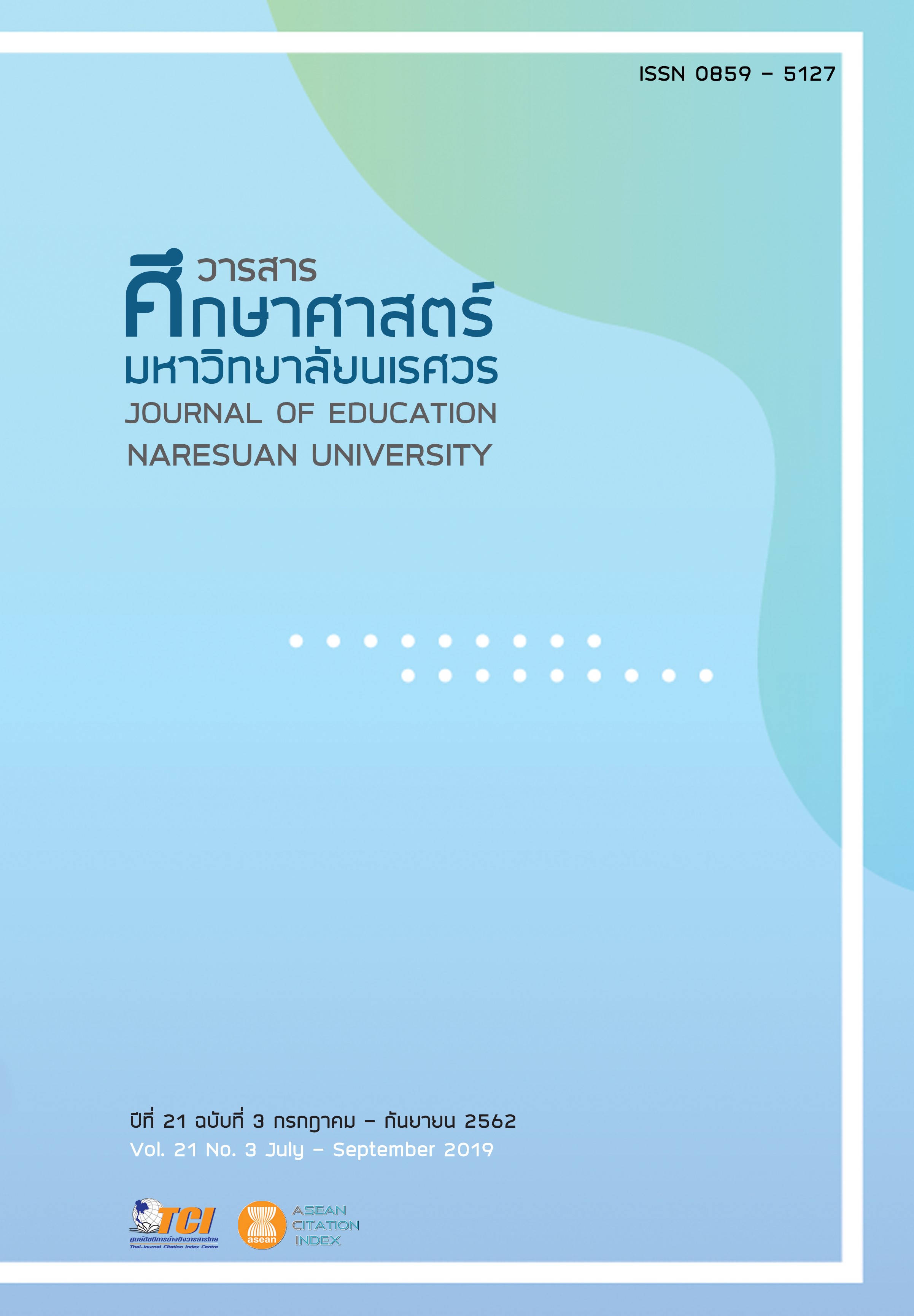โมเดลสมการโครงสร้างปัจจัยที่มีอิทธิพลต่อความเป็นโรงเรียนแห่งนวัตกรรมของโรงเรียนมัธยมศึกษา สังกัดสำนักงานคณะกรรมการการศึกษาขั้นพื้นฐาน (A STRUCTURAL EQUATION MODEL OF FACTORS INFLUENCING FOR INNOVATIVE SECONDARY SCHOOLS IN THE OFFICE OF THE BASIC EDUCATION COMMISSION)
Main Article Content
Abstract
การวิจัยครั้งนี้มีวัตถุประสงค์ คือ 1) ศึกษาระดับปัจจัยที่มีอิทธิพลต่อความเป็นโรงเรียนแห่งนวัตกรรมของโรงเรียนมัธยมศึกษา และเปรียบเทียบระดับปัจจัยที่มีอิทธิพลต่อความเป็นโรงเรียนแห่งนวัตกรรม เมื่อจำแนกตามขนาดของโรงเรียน 2) ศึกษาระดับความเป็นโรงเรียนแห่งนวัตกรรมของโรงเรียนมัธยมศึกษา และเปรียบเทียบระดับความเป็นโรงเรียนแห่งนวัตกรรม เมื่อจำแนกตามขนาดของโรงเรียน และ 3) ตรวจสอบความสอดคล้องโมเดลสมการโครงสร้างปัจจัยที่มีอิทธิพลต่อความเป็นโรงเรียนแห่งนวัตกรรมที่พัฒนาขึ้นกับข้อมูลเชิงประจักษ์ กลุ่มตัวอย่าง คือ โรงเรียนมัธยมศึกษา 400 โรงเรียน โดยวิธีสุ่มแบบแบ่งชั้น เครื่องมือการวิจัยเป็นแบบสอบถามแบบมาตรประมาณค่า 5 ระดับ มีค่าดัชนีความสอดคล้องของคำถามและวัตถุประสงค์ ระหว่าง 0.57-1.00
ค่าความเชื่อมั่น ตอนที่ 2 ปัจจัยที่มีอิทธิพล เท่ากับ 0.99 และตอนที่ 3 ความเป็นโรงเรียนแห่งนวัตกรรม เท่ากับ 0.98 สถิติที่ใช้วิเคราะห์ข้อมูล ได้แก่ 1) ค่าเฉลี่ย 2) ค่าส่วนเบี่ยงเบนมาตรฐาน 3) การวิเคราะห์ความแปรปรวนทางเดียว (One Way Anova) 4) การวิเคราะห์องค์ประกอบเชิงยืนยัน (Confirmatory Factor Analysis) และ 5) การวิเคราะห์โมเดลสมการโครงสร้าง (SEM) ผลการวิจัย พบว่า
1. โรงเรียนมัธยมศึกษามีระดับปัจจัยที่มีอิทธิพลต่อความเป็นโรงเรียนแห่งนวัตกรรมอยู่ในระดับมาก เมื่อขนาดโรงเรียนต่างกัน จะมีระดับปัจจัยที่มีอิทธิพลไม่แตกต่างกัน
2. โรงเรียนมัธยมศึกษามีระดับความเป็นโรงเรียนแห่งนวัตกรรมอยู่ในระดับมาก เมื่อขนาดโรงเรียนต่างกัน จะมีระดับความเป็นโรงเรียนแห่งนวัตกรรมแตกต่างกัน อย่างมีนัยสำคัญทางสถิติที่ระดับ .05 โดยโรงเรียนขนาดใหญ่พิเศษแตกต่างจากขนาดกลาง อย่างมีนัยสำคัญที่ระดับ .05
3. โมเดลสมการโครงสร้างปัจจัยที่มีอิทธิพลต่อความเป็นโรงเรียนแห่งนวัตกรรมที่พัฒนาขึ้นสอดคล้องกับข้อมูลเชิงประจักษ์ การจัดการกลยุทธ์ที่มุ่งนวัตกรรม มีอิทธิพลรวมสูงสุดต่อความเป็นโรงเรียนแห่งนวัตกรรม โดยสัดส่วนความเชื่อถืออธิบายด้วยปัจจัยทั้งหมด ได้ร้อยละ 93
A STRUCTURAL EQUATION MODEL OF FACTORS INFLUENCING FOR INNOVATIVE SECONDARY SCHOOLS IN THE OFFICE OF THE BASIC EDUCATION COMMISSION
The objectives of this research were to 1) study and compare the level of influencing factors for Innovative secondary schools in the Office of the basic education commission classified by school size, 2) study and compare the level of Innovative secondary schools classified by school size, and 3) verified a structural equation model of factors influencing innovative secondary developed with empirical data. The samples in this study were 400 schools which stratified random sampling. The research instruments were a rating scale questionnaire. The index of item objective congruence ranged from 0.57 to 1.00. The reliability of the Part 2 in questionnaire was 0.99 and Part 3 was 0.98. The statistic use for analyzed data were 1) Mean, 2) Standard Deviation, 3) One Way ANOVA, 4) Confirmatory Factor Analysis, and 5) Analysis of Equation Modeling (SEM).
The research findings were as follows:
1. Secondary schools had a high level of influence and when the size of the school is different the level of influence factor was not significant.
2. Secondary schools had a high level of innovative school and when the size of the school is different the level of innovative school was significant difference at .05. It was found that the different from a school with extra-large size and medium size significantly at the .05 level.
3. A structural equation model of factors that influence for innovative school under the office of the basic education commission. The development is consistent with empirical data. According to the following criteria and find that Innovative strategy management factors that has Influence of total influence on innovative. The proportion of reliability in the innovative school explained by all factors was 93 percent.
Article Details
The owner of the article does not copy or violate any of its copyright. If any copyright infringement occurs or prosecution, in any case, the Editorial Board is not involved in all the rights to the owner of the article to be performed.
References
2. Chuttitonpong, J. (2000). Knowledge management to create innovations of non-academic staff of autonomous universities (Master thesis). Nakhon Si Thammarat: Walailak University. [in Thai]
3. Dale W. Lick, et al. (2013). Schools can change a step-by-step change creation system for building innovative schools and increasing student learning. California: Corwin a Sage Company.
4. Ismail, W. K. W., & Abdmajid, R. (2007). Framework of the culture of innovation: A revisit. Journal Kemanusiaan bil, 9, 38-49.
5. Jitsavang, N. (2012). Innovations in government organizations. Retrieved on March 2, 2015, from https://www.gotoknow.org/posts/497548 [in Thai]
6. Jueyto, S. (2003). Innovation management: New science of management. Journal of Modern Management, 1(1), 35-43. [in Thai]
7. Lien, B. Y., & Mclean, G. N. (2004). Portraits of Taiwanese HR practitioners performing HRD tasks. Human Resource Development International, 7(1), 73-83.
8. National Productivity Institute. (2006). Knowledge Management From theory to practice (3rd ed.). Bangkok: Chiravat Express. [in Thai]
9. National Innovation Agency. (2006). Management innovation for executives (2nd ed.). Bangkok: National Innovation Agency. [in Thai]
10. Parangkoon, C. (2013). A study of organizational innovation of Basic Education Institutes under the Office of Basic Education Commission in Ratchaburi Province (Research Report). Ratchaburi: Chom Bueng Rajabhat University. [in Thai]
11. Prachankat, O. (2004). Organization of innovation education: A new choice of educational administration. Retrieved on May 2, 2015, from https://www.tcithaijo.org/index.php/JRTAN/article/view/18430 [in Thai]
12. Sila, K. (2013). The study of formative leadership of school principals in the school under the Bangkok metropolis, administrative office of Bangkhen district (Master thesis). Bangkok: Srinakharinwirot University. [in Thai]
13. Tanprapat, C. (2000). Factors effecting to creativity and innovation of private schools in basic education level (Doctoral dissertation). Chonburi: Burapha University. [in Thai]
14. Tonak, K., Chamchoy, S., & Kornpuang, A. (2014). Factor analysis of innovation leadership for basic school administrators. Journal of Education Naresuan University, 16(4), 134-135. [in Thai]
15. Wanibancha, K. (2014). Structural Equation Analysis (SEM) with AMOS (2nd ed). Bangkok: Samlada.
[in Thai]
16. Wichirapanang, K. (1996). Tools development to evaluate the factors of public innovative organization (Master thesis). Bangkok: King Mongkut's University of Technology Thonburi. [in Thai]
17. Yawirat, N. (2003). Leadership and strategic leadership. Bangkok: Central Express. [in Thai]
18. Yotyingyong, K. (1999). Innovative organization concepts and processes. Bangkok: Chulalongkorn University. [in Thai]


